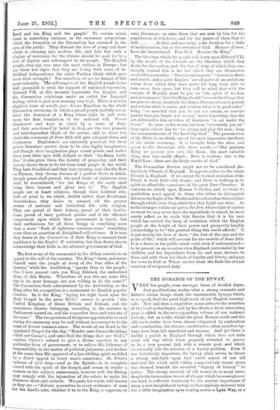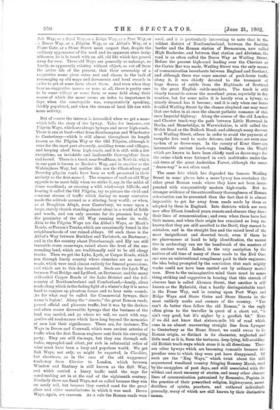THE ROMANCE OF THE BYWAY.
VERY few people, even amongst those of decided dryas- dust predilections, realise what a strong romantic and historic charm bangs about the innumerable byways which, so to speak, feed the great high-roads of our English country- side. Now and then a suggestive name attracts the attention of the local archmologist, and by his efforts a fresh interesting page is added to the ever-expanding volume of our national history; but as a rule, whilst the great Roman roads and the old coach routes have been almost vulgarised by exploration and examination, the obscure, unobtrusive, often nameless by- ways have been left unnoticed and unsung. And yet there is hardly a parish in England through which does not sidle some old way which when properly attended to proves to be a very present link with a remote past, and which occasionally aids the solution of a knotty problem. Even if not historically important, the byway often serves to throw a strong side-light upon that social aspect of our old national life which until within comparatively recent years was deemed beneath the so-called "dignity of history" to notice. The strong survival of old names in so many cases, despite the tremendous waves of change which have swept over our land, is sufficient testimony to the ancient importance of many a now insignificant byway, so that anybody endowed with but a little imagination upon coming across a Lyke Way, or a
Salt Way, or a Sand Way, or a Ridge Way. cr a Port Way, or . a Drove Way, or a Pilgrim Way, or an Abbot's Way, or a Stane Gate, or a Stone Street must suspect that, despite the ordinary appearance of the road and its apparent utter insig- nificance, he is in touch with an old, old life which has passed away for ever. These old Ways are generally so unkempt, so lonely, so apparently existing without object, so cut off from the active life of the present., that their ownership of a suggestive name gives extra zest and charm to the task of rummaging up old maps and documents and local records in order to get at some facts about them. And even when they hear no suggestive names or none at all, there is pretty sure to be some village or some farm or some field along their course of which the name seems an index to importance in days when the countryside was, comparatively speaking, thickly populated, and when the stream of local life ran with some activity.
But of course the interest is intensified when we get a name which tells the story of the byway. Take, for instance, our Pilgrim Ways, which are always byways and never high-roads. There is one at least—that from Southampton and Winchester to Canterbury—which is still almost throughout its length known as the Pilgrim Way or the Old Pilgrim, although it runs for the most part obscurely, avoiding towns and villages, and keeping aloof from high-roads, and it is still, with a few exceptions, an inviolable and inalienable thoroughfare from end to end. There is a track near Swaffham, in Norfolk, which in one part is known as Becket's Way, and in another as the Walsingham Way, but neither this nor the Glastonbury and Beverley pilgrim roads have been so well preserved in their entirety as the first-named. The romance of such an old Way appeals to us most fully when we strike it, say, in the midst of dense woodland ; or crossing a wild, wind-swept hillside, and hearing it called the Old Pilgrim, try to picture the vivid and constant stream of traffic which during so many centuries made the solitude around us a stirring, busy world ; or when, as at Boughton Aluph, near Canterbury, we come upon a large, stately church standing almost alone in a world of fields and woods, and can only account for its presence here by the proximity of the old Way running under its walls. Akin to the Pilgrim Ways are the Abbot's Ways, or Monk's Roads, or Parson's Tracks, which are occasionally found in the neighbourhoods of our ruined abbeys. Of such there is the Abbot's Way between Buckfast and Tavistock, on Dartmoor ; and in the flat country about Peterborough and Ely are still traceable stone causeways, raised above the level of the sur- rounding land, which are traditionally said to be old clergy tracks. Then we get the Lyke, Lych, or Corpse Roads, which run through lonely country where churches are as rare as roads, which were used almost entirely for funeral processions, and which are to this day haunted. Such are the Lych Way between Post Bridge and Lydford, on Dartmoor, and the many still-called -Corpse Roads of the Lake District and the fell- country of Northumberland and Cumberland,—lonely, silent roads along which in the fading light of a winter's day it is never hard to conjure up phantom forms and to hear eerie sounds. As for what may be called the Commercial byways, their name is legion ! Along the "streets," the great Roman roads, passed official and pleasure traffic, but it was by the devious and often scarce discernible byways that the business of the land was carried, and go where we will, we meet with sug- gestive old road-names which have long beyond the memories of men lost their significance. There are, for instance, Tin Ways in Devon and Cornwall, which were ancient arteries of traffic when the first Roman engineer sent forth his surveying party. They are still tin-ways, but they run through soli- tudes, unpeopled and silent, yet rich in substantial relics of what must have been a busy and populous world. We get Salt Ways, not only, as might be expected, in Cheshire, but elsewhere, as in the case of the old waggoners' track-way from Chester to London, which between Winslow and Banbury is still known as the Salt Way, and which carried a heavy traffic until the rage for canal-making set in at the end of the eighteenth century. Similarly there are Sand Ways, not so called because they run on sandy soil, but because they carried sand for the great glass and other manufactures in which it was used. Drove Ways, again, are common. As a rule the Roman roads were
• used, and it is particularly interesting to note that in the wildest district of Northumberland, between the Scottish border and the Roman station of Bremenium, now called High Rochester, and between that station and Alwinton, the road is as often called the Drove Way as Watling Street. Before the present high-road leading over the Cheviots at the Carter Bar was made, Watling Street was the only means of communication hereabouts between England and Scotland, and although there was some amount of pack-horse traffic along it, it was chiefly devoted to the transport or huge droves of cattle from the Highlands of Scotland to the great English cattle-markets. The track is still clearly traceable across the moorland grass, especially in dry weather, but for some miles it is hardly even a byway, so utterly disused has it become ; and it is only when one hears it called Watling Street by the chance shepherd one may meet that one takes in at once the almost pathetic romance of this once Imperial highway. Along the course of the old London and Chester track-way the path between Little Horwood. in Bucks, and Stonebridge, in Warwickshire, is still called the Welsh Road or the Bullock Road; and although many drovers used Watling Street, others in order to avoid the payment of turnpike fees used to make detours, and these are even now spoken of as drove-ways. In the county of Kent there are innumerable ancient track-ways leading from the Weald which arc known to have been chiefly used as drove-ways for the swine which were fattened in such multitudes under the oak-trees of the great Anderidan Forest, although the name "drove-way" is not often used.
The same fate which has degraded the famous Watling Street in some places into a mere byway has overtaken the other great Roman roads where they have not been incor- porated with comparatively modern high-roads. But no stronger evidence of the extraordinary thoroughness of Roman colonisation can be presented than the fact that it is almost impossible to get far away from roads made by them or adapted by them in England. Into districts which are even now after fifteen hundred years remote and obscure they drove their lines of communication ; and even when these have lost their names, and when their origin has remained so long un- known that they are still ascribed to the Devil, they cannot be mistaken, and in the straight line and the raised level of the most insignificant and deserted track, even if there be no place-names at hand to help identification, the merest tiro in archxology can see the handiwork of the masters of the ancient world. Indeed, in the very ascription by the natives of old time of many of these roads to the Evil One, one sees an unintentional compliment paid to their engineers, the idea being prompted by the conviction that such mighty works could not have been carried out by ordinary mortal men. Even to the unimaginative mind there must be some- thing striking and suggestive in bearing that this stretch of obscure lane is called Akeman Street, that another is still known as the Ryknield, that a hardly distinguishable track is the Fosse Way, and in coming upon Port Ways and Ridge Ways and Stane Gates and Stone Streets in the most unlikely nooks and corners of the country. "You can't do better than follow the old Roman," is the reply often given to the traveller in quest of a short cut, "it ain't very good, but it's nigher by a goodish bit." Even if we did not know that sixteen-mile bit of road which runs in an almost unswerving straight line from Lympne to Canterbury as the Stone Street, we could swear to its Roman origin, so distinct is its character, neglected and little used as it is, from the tortuous, deep-lying, hill-avoiding old British track-ways which cross it in all directions. There are other byways which are becoming romantic because the peculiar uses to which they were put have disappeared. Of such are the "Keg Ways," which twist about the still sequestered woodland country fringing Romney Marsh, used by the smugglers of past days, and still associated with the wildest and most uncanny of stories, and many other obscure lines of communication patronised by Romanies, Papists in the practice of their prescribed- religion, highwaymen, secret distillers of spirits, poachers, and outlawed individuals generally, many of which are 'still known by their distinotive names.







































 Previous page
Previous page